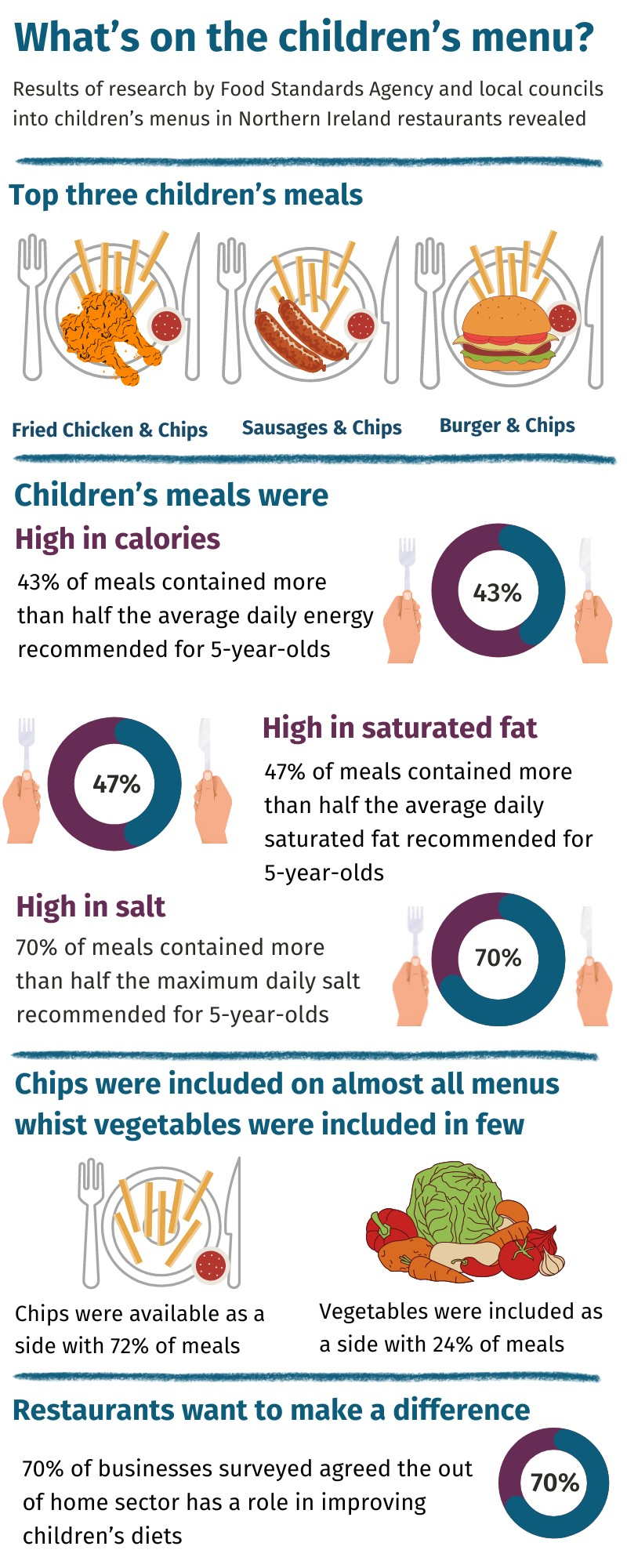Research by Council and FSA reveals children’s menus need improvement
Mon, March 25, 2024
The Mayor of Causeway Coast and Glens Borough Council has welcomed research by the FSA in partnership with councils across Northern Ireland which revealed local children’s menus are lacking healthy options.
Reacting to the findings of the report What’s on the Children’s Menu, Councillor Steven Callaghan said: “This important research shows more needs to be done to help and encourage children to make healthier choices when they are eating out in our restaurants around the Borough – and to support local chefs to provide more nutritious options.
“We are privileged to have some of the best, freshest produce on our doorstep and if local restaurants can use those ingredients in a way that is both nourishing and tasty, children will reap the health benefits.”
The Food Standards Agency (FSA) has revealed the results of research undertaken in partnership with councils across Northern Ireland into children’s meals served in restaurants locally.
Environmental Health Manager Alexis Gamble of Causeway Coast and Glens Borough Council chairs the overarching council food and nutrition group through which the work was undertaken.
Explaining the findings, she said: “Families in Northern Ireland eat out regularly and so food businesses such as restaurants, fast food outlets and cafés have significant influence over consumer diets.
“As evidence suggests, food prepared out of the home tends to be higher in energy, saturated fat, sugar and salt and lower in fruit and vegetables than meals prepared at home.”
The Food Standards Agency (FSA) and Causeway Coast and Glens Borough Council – along with other councils across Northern Ireland - conducted research into the foods available to children when eating out and the nutritional content of this food.
Key findings of the research, which are published in a report entitled What’s on the Children’s Menu, can be found here. They included:
Choice was limited on children’s menus and few healthy options were available.
The most popular children’s meals were fried chicken and chips, sausages and chips and a burger and chips.
The most popular children’s meals were high in energy, saturated fat and salt –
43% of meals contained more than half the average amount of energy recommended for 5-year-olds.
47% of meals contained more than half the average amount of saturated fat recommended for 5-year-olds.
70% of meals contained more than half the maximum amount of salt recommended for 5-year-olds.
Chips were available as a side with 72% of meals on children’s menus while vegetables were available with 24% of meals.
Outlining steps that are being taken to support businesses on this issue, Professor Susan Jebb OBE, Chair of the Food Standards Agency said: “I am delighted that the FSA has been able to conduct this important research as part of our contribution to the NI Obesity prevention strategy. The findings show that work is needed to improve the nutritional quality of food available to children when eating out.
“Encouragingly, however, most restaurant owners and managers surveyed saw their sector as having a role in improving children’s diets. To support restaurants to do this, the FSA has published ‘Healthier catering tips for children's menus’.
“The guidance, which is freely available to download, provides tips for businesses on inexpensive steps they can take to improve the nutritional value of their children’s meals.”
Commenting on the research findings, Noyona Chundur, Chief Executive of the Consumer Council for Northern Ireland, said:
“The Consumer Council’s food research over the past two years highlights parents’ keenness to provide a healthy and varied diet for their children. However, our research also heard about difficulties faced by parents with children who are picky eaters.
“This is where the FSA’s Catering tips for children’s menus, which accompanies this report, is such a useful tool. It strikes a good balance between providing food that younger diners may expect to see on the menu but gives guidance on preparing it in a healthier way.”
The Healthier Children’s Menus Guidance is just one channel of support available to restaurants. The FSA also provides a free online tool, MenuCal, that enables businesses to calculate energy information of the meals they provide.


